The Atlantic Coast of Portugal
Next spring (2006) Sarah and I will be heading down the coast of Portugal
and Spain, heading for the Mediterranean Sea. While Jack & Nikki were
visiting me in Cascais in December, 2005 we used a rental car to drive
partially down the coast of Portugal to visit potential harbors I might use
next spring. There are very few small craft harbors between the Rio Tejo
and the Algarve and we surveyed most of them. |
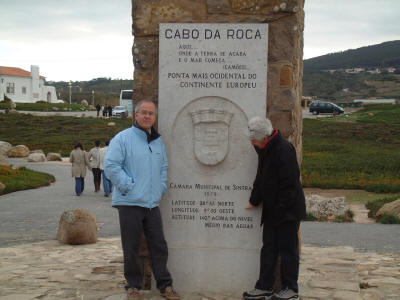 Cabo
da Rocha
is the cape north of the Rio Tejo. It is the western-most land
on the continent of Europe. Cabo
da Rocha
is the cape north of the Rio Tejo. It is the western-most land
on the continent of Europe. |
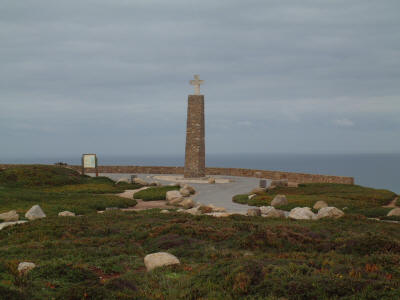 |
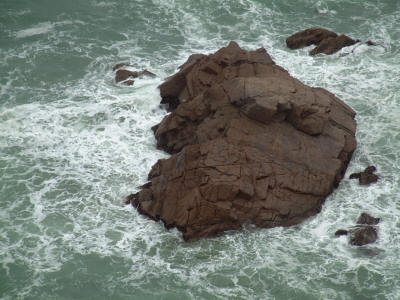 |
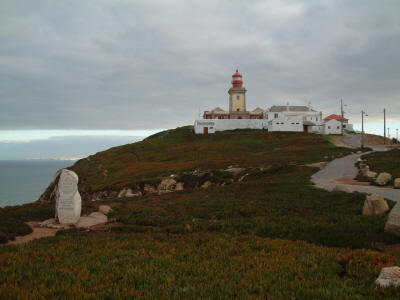 |
| Setubal
is the 3rd largest city in Portugal (behind Lisboa and Porto), and I thought
the Doca de Recreio in that harbor might provide a convenient short stopover
once I leave the Rio Tejo. |
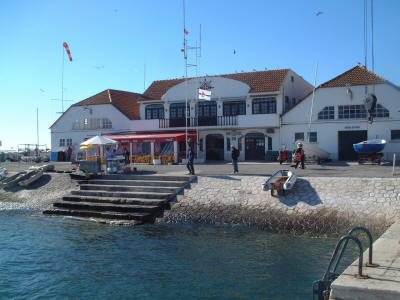 Here
is the clubhouse of the Club Naval de Setubal and the head of the
recreational harbor (Doc de Recreio). Here
is the clubhouse of the Club Naval de Setubal and the head of the
recreational harbor (Doc de Recreio). |
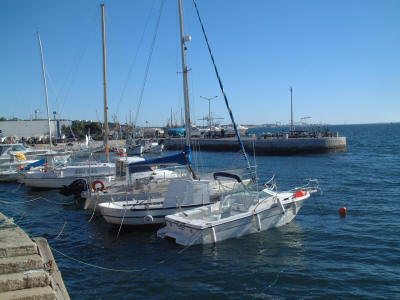 Unfortunately
the recreational harbor is very small with minimalist Med-Style moorings and
little protection when the seas are out of the south. This does not look
like a viable marina for Sarah, although it would be possible to anchor
outside of the harbor in settled conditions. Unfortunately
the recreational harbor is very small with minimalist Med-Style moorings and
little protection when the seas are out of the south. This does not look
like a viable marina for Sarah, although it would be possible to anchor
outside of the harbor in settled conditions. |
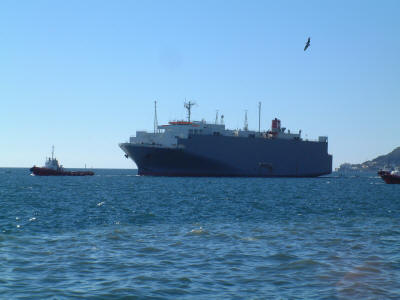 Setubal
is a moderately busy commercial harbor. This looks like a car carrier
coming into port.. Volkswagon operated a large assembly plant across
the Rio Tejo from Lisboa and it appears they shipped those cars out of
Setubal. Setubal
is a moderately busy commercial harbor. This looks like a car carrier
coming into port.. Volkswagon operated a large assembly plant across
the Rio Tejo from Lisboa and it appears they shipped those cars out of
Setubal. |
This is the Doca de Pescadores (Fisherman Harbor) next to
the marina in Setubal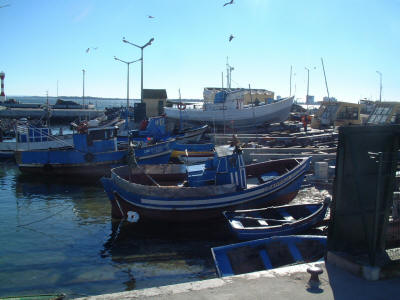 |
| |
|
| Sines is
further down the coast, about 2/5 of the way from the Rio Tejo to Cabo Sao
Vicente and the Algarve. |
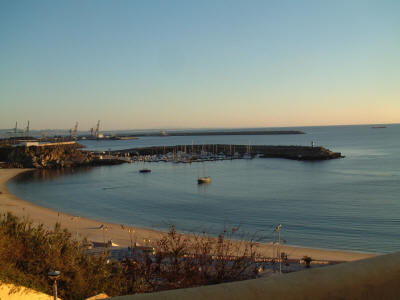 Although
still under construction (the offices and other facilities are in trailers),
the marina at Sines is well designed and well protected by two sets of
breakwaters. Although
still under construction (the offices and other facilities are in trailers),
the marina at Sines is well designed and well protected by two sets of
breakwaters. |
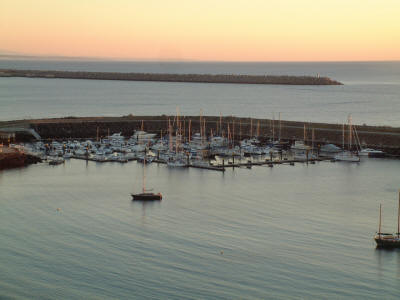 Although
not a large marina there are a number of empty slips available for
transients. Sines is primarily a port for oil tankers and is heavily
industrial with no major city in the vicinity. It is unlikely that this
marina will completely fill with local boats although there is still a lot
of condo construction going on in the residential area north of the marina. Although
not a large marina there are a number of empty slips available for
transients. Sines is primarily a port for oil tankers and is heavily
industrial with no major city in the vicinity. It is unlikely that this
marina will completely fill with local boats although there is still a lot
of condo construction going on in the residential area north of the marina. |
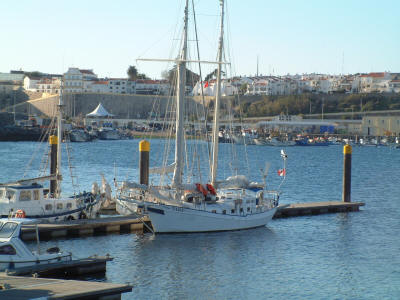 While
visiting Sines we met one of the Canadians sailing on this large schooner.
This boat anchored next to us for a few days while we were in Lajes on
Flores, the Azores. They spent a month more than we did in the Azores then
sailed to Spain. There were held up coming south by the rough weather of
the past two monts and the southerly winds. It appears they will keep
harbor hoping whenever a weather window opens up and not stop permanently
for the winter. While
visiting Sines we met one of the Canadians sailing on this large schooner.
This boat anchored next to us for a few days while we were in Lajes on
Flores, the Azores. They spent a month more than we did in the Azores then
sailed to Spain. There were held up coming south by the rough weather of
the past two monts and the southerly winds. It appears they will keep
harbor hoping whenever a weather window opens up and not stop permanently
for the winter. |
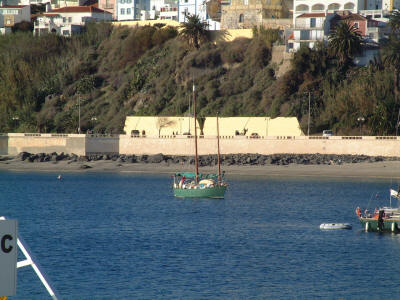 Below
is small schooner anchored in the harbor at Sines, was being single handed
by a Brit. He also was anchored with us in Lajes and had been sailing with
the Canadian schooner ever since. Below
is small schooner anchored in the harbor at Sines, was being single handed
by a Brit. He also was anchored with us in Lajes and had been sailing with
the Canadian schooner ever since.Cruising really is a small world. |
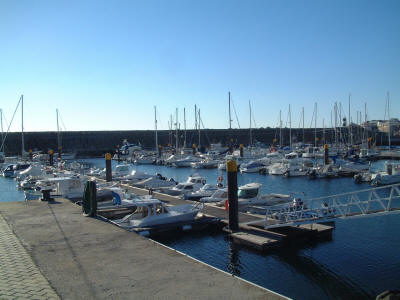 These
are the floating pontoons at the Sines Marina. Similar construction and
configuration to all of the newer marinas I have encountered in the Azores
and Portugal, including Cascais. These
are the floating pontoons at the Sines Marina. Similar construction and
configuration to all of the newer marinas I have encountered in the Azores
and Portugal, including Cascais. |
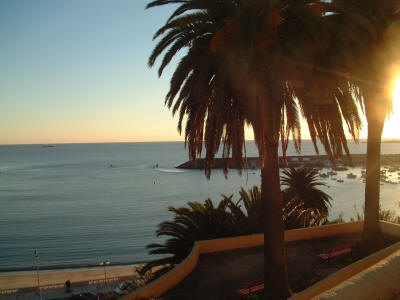 The
outer breakwaters at Sines provide excellent protection for the marina
behind its own internal breakwater. The
outer breakwaters at Sines provide excellent protection for the marina
behind its own internal breakwater. |
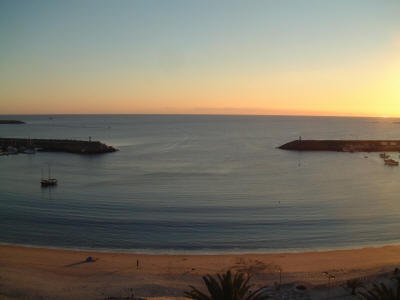 This
also provides a large and well protected anchorage. This
also provides a large and well protected anchorage. |
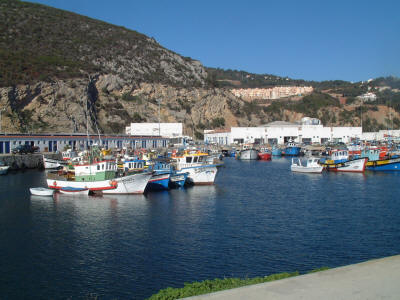 Sesimbra
is a small fishing town just below the Cabo de Espichel, the southern cape
at the mouth of the Rio Tejo. The village is no longer a sleepy hamlet as
it has been discovered as a weekend destination for Lisboans. There many
large high-rise apartment buildings ringing the town. Sesimbra
is a small fishing town just below the Cabo de Espichel, the southern cape
at the mouth of the Rio Tejo. The village is no longer a sleepy hamlet as
it has been discovered as a weekend destination for Lisboans. There many
large high-rise apartment buildings ringing the town. |
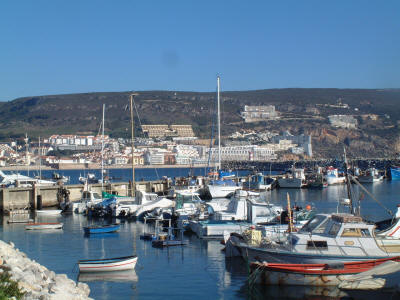 |
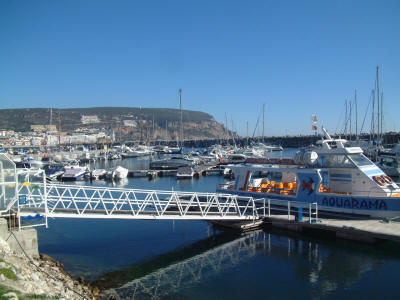 The
marina at Sesimbra is small but fairly new and well-maintained. The docks
are the same floating pontoons as seen at most of the modern marinas in
Portugal. It is certainly a better option for an overnight stay than
Setubal, but it is so close to Lisboa that it may not be worth the stop,
I'll likely just press on to Sines. The
marina at Sesimbra is small but fairly new and well-maintained. The docks
are the same floating pontoons as seen at most of the modern marinas in
Portugal. It is certainly a better option for an overnight stay than
Setubal, but it is so close to Lisboa that it may not be worth the stop,
I'll likely just press on to Sines. |
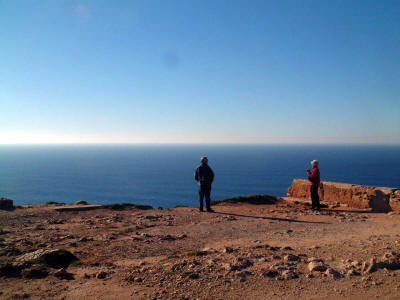 Cabo
de Espichel is the large headland that marks the southern end
of the Rio Tejo mouth. Cabo
de Espichel is the large headland that marks the southern end
of the Rio Tejo mouth. |
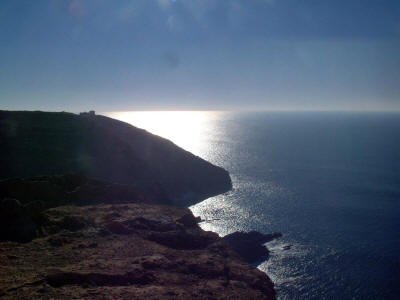 |
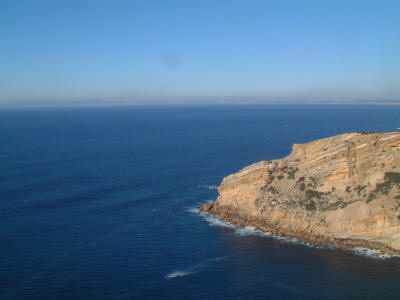 |